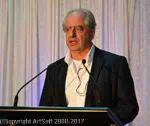William Kentridge
William Kentridge
Born: 1955
Biography:
William Kentridge is a South African artist best known for his prints, drawings, and animated films. These are constructed by filming a drawing, making erasures and changes, and filming it again. He continues this process meticulously, giving each change to the drawing a quarter of a second to two seconds' screen time. A single drawing will be altered and filmed this way until the end of a scene. These palimpsest-like drawings are later displayed along with the films as finished pieces of art.
Kentridge was born in Johannesburg to Sydney Kentridge and Felicia Geffen. Both were attorneys who represented people marginalized by the apartheid system. He was educated at King Edward VII School in Houghton, Johannesburg. He showed great artistic promise from an early age, and in 2016 became the first artist ever to have a catalogue raisonné devoted to his juvenilia. He earned a Bachelor of Arts degree in Politics and African Studies at the University of the Witwatersrand and then a diploma in Fine Arts from the Johannesburg Art Foundation. In the early 1980s, he studied mime and theatre at the L'École Internationale de Théâtre Jacques Lecoq in Paris. He originally hoped to become an actor, but he reflected later: "I was fortunate to discover at a theatre school that I was so bad an actor I was reduced to an artist, and I made my peace with it.". Between 1975 and 1991, he was acting and directing in Johannesburg's Junction Avenue Theatre Company. In the 1980s, he worked on television films and series as art director.
As someone who is ethnically Jewish in South Africa, Kentridge has a unique position as a third-party observer. His parents were lawyers, famous for their defence of victims of apartheid. Kentridge developed an ability to remove himself somewhat from the atrocities committed under the later regimes. The basics of South Africa's socio-political condition and history must be known to grasp his work fully, much the same as in the cases of such artists as Francisco Goya and Käthe Kollwitz.
Kentridge is of expressionist lineage: form often alludes to content and vice versa. The feeling that is manipulated by the use of palette, composition and media, among others, often plays an equally vital role in the overall meaning as the subject and narrative of a given work. One must use one's gut reactions as well as one's interpretive skills to find meaning in Kentridge's work, much of which reveals very little actual content. Due to the sparse, rough and expressive qualities of Kentridge's handwriting, however, the viewer sees a sombre picture upon first glance, an impression that is perpetuated as the image illustrates a vulnerable and uncomfortable situation.
Aspects of social injustice that have transpired over the years in South Africa have often become fodder for Kentridge's pieces. Casspirs Full of Love, viewable at the Metropolitan Museum, appears to be nothing more than heads in boxes to the average American viewer, but South Africans know that a casspir is a vehicle used to put down riots, a kind of a crowd-control tank.
The title, Casspirs Full of Love, written along the side of the print, is suggestive of the narrative and is oxymoronic. A casspir full of love is much like a bomb that bursts with happiness - it is an intangible improbability. The purpose of a machine such as this is to instil "peace" by force, but Kentridge points to the fact that it was used as a tool to keep lower-class natives from taking colonial power and money.
By the mid-1970s, Kentridge was making prints and drawings. In 1979, he created 20 to 30 monotypes, which soon became known as the "Pit" series. In 1980, he executed about 50 small-format etchings which he called the "Domestic Scenes". These two extraordinary groups of prints served to establish Kentridge's artistic identity, an identity he has continued to develop in various media. Despite his ongoing exploration of non-traditional media, the foundation of his art has always been drawing and printmaking.
In 1987, he began a group of charcoal and pastel drawings based, very tenuously, on Watteau's Embarkation for Cythera. These extremely important works, the best of which reflect a blasted, dystopic urban landscape, demonstrate the artist's growing consciousness of the flexibility of space and movement.
In 1996-1997, he produced a portfolio of eight prints titled Ubu Tells the Truth, based on Alfred Jarry's 1896 play Ubu Roi. These prints also relate to the Truth and Reconciliation Commission in Kentridge's South Africa after the end of apartheid One of the stark and somber prints from this portfolio, in the collection of the Honolulu Museum of Art, is illustrated.
The Six Drawing Lessons, delivered as part of The Norton Lectures series at Harvard University in 2012, consider the work in the studio and the studio as a place of making meaning developed. A series of large drawings of trees in Indian ink on found encyclopedia pages, torn up and reassembled, analyzes the form of different trees indigenous to southern Africa. Drawn across multiple pages from books, each drawing is put together as a puzzle – the single pages first painted, then the whole pieced together.
More...
Wikipedia link: Click Here




